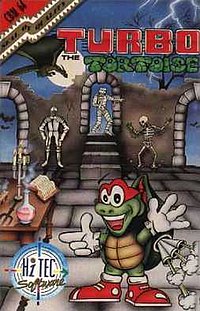
Rick Dangerous is a platform game developed by Core Design for the Acorn Archimedes, Amiga, Atari ST, Amstrad CPC, ZX Spectrum, Commodore 64, and MS-DOS. The game was released in 1989 and published by MicroProse on the Firebird Software label in the UK, and on the MicroPlay label in America. It was also published in Spain by Erbe Software. Later, it was released with two other games, Stunt Car Racer and MicroProse Soccer, on the Commodore 64 Powerplay 64 cartridge. The game was followed by a sequel, Rick Dangerous 2, in 1990. Loosely based on the Indiana Jones film franchise, the game received mixed reviews from critics.

Emlyn Hughes International Soccer (EHIS) is a soccer computer game first released in 1988 by Audiogenic Software Ltd. The game is named after the popular English footballer Emlyn Hughes. It initially appeared on the Commodore 64, with other versions produced for the Amstrad CPC, ZX Spectrum, Atari ST and Amiga.
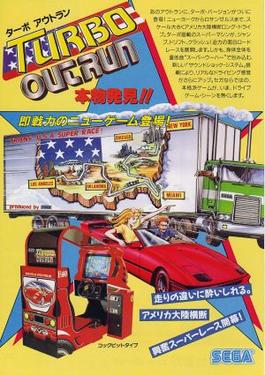
Turbo OutRun (ターボアウトラン) is a 1989 arcade racing game released by Sega. A follow-up to 1986's Out Run, it was released as a dedicated game, as well as an upgrade kit for the original Out Run board.
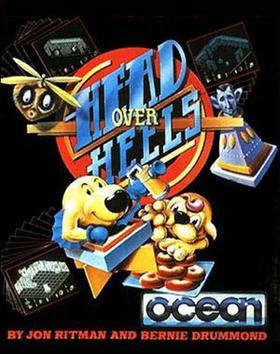
Head Over Heels is an action-adventure game published by Ocean Software in 1987 for several home computers. It uses an isometric engine similar to the Filmation technique first developed by Ultimate Play the Game. Head Over Heels is the second isometric game by Jon Ritman and Bernie Drummond, after their earlier Batman computer game was released in 1986. The game received favourable reviews and was described by Zzap!64 as an "all time classic".
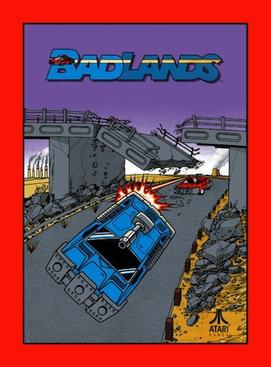
Badlands is a 1989 arcade video game published by Atari Games. It was ported by Domark under the Tengen label to the Amiga, Amstrad CPC, Atari ST, Commodore 64, and ZX Spectrum. The game is a re-themed version of Atari's previous racing games Super Sprint and Championship Sprint with the addition of vehicular combat. Badlands is set in the aftermath of a nuclear war and races around abandoned wastelands with many hazards. Three gun-equipped cars race around a track to win prizes.
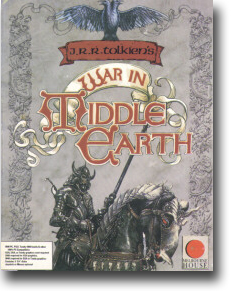
War in Middle Earth is a real-time strategy game released for the ZX Spectrum, MSX, Commodore 64, Amstrad CPC, MS-DOS, Amiga, Apple IIGS, and Atari ST in 1988 by Virgin Mastertronic on the Melbourne House label.

The Untouchables is a video game released by Ocean Software in 1989 on ZX Spectrum, Amstrad CPC, Commodore 64, MSX, Atari ST, Amiga, DOS, NES, and SNES. It is based on the film The Untouchables.

Knightmare is a video game released by Activision in 1987 for ZX Spectrum, Amstrad CPC, Commodore 64, and Atari ST. It was written by Mev Dinc, J.P. Dean, E.M. Dean and Nick Cooke, and is based on the Anglia Television show Knightmare. Four years later, Mindscape released entirely different game based on the show, also called Knightmare, for the Atari ST and Amiga.
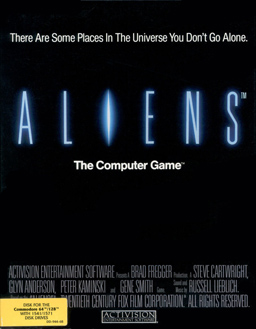
Aliens: The Computer Game is a 1986 video game developed and published by Activision for the Commodore 64, Apple II based on the film of the same title. As Activision's UK subsidiary Electric Dreams Software had independently released their own version of the game with the same title, the game was renamed for European release. Initially planned to be released as Aliens: The Second Part., it was finally published under the title Aliens: US Version with ports for the Amstrad CPC and ZX Spectrum produced by Mr Micro.

Welltris is a puzzle video game, developed by Doka and licensed to Bullet-Proof Software. It is an official game in the Tetris series. Adaptations were made by Sphere, Inc., for Spectrum HoloByte, and by Infogrames. It was released for MS-DOS compatible operating systems in 1989. Ports for Macintosh, Amiga, Amstrad CPC, and Atari ST followed in 1990, then ZX Spectrum and Commodore 64 in 1991.

A View to a Kill are two separate video games released in 1985 and based on the James Bond film A View to a Kill. The first, an action game titled A View to a Kill: The Computer Game, was developed and published by Domark. It was available for the ZX Spectrum, Amstrad CPC, Commodore 64, MSX, and Oric. The second game, James Bond 007: A View to a Kill, is a text-based adventure for MS-DOS, Macintosh, and Apple II. It was developed by Angelsoft, and published by Mindscape.
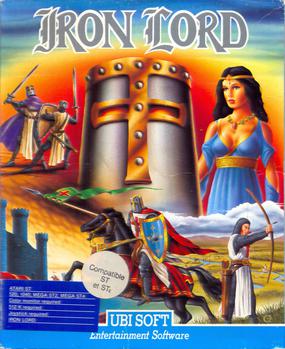
Iron Lord is an adventure video game developed by Orou Mama and Ivan Jacot for the Atari ST and published by Ubi Soft in 1989. It was ported to the Amiga, Acorn Archimedes, Amstrad CPC, Commodore 64, ZX Spectrum, and MS-DOS.

Zub is a 1986 platform video game designed by Ste and John Pickford, developed by Binary Design, and published by Mastertronic for the Amstrad CPC, Commodore 64 and ZX Spectrum. The game has the player control Zub, who has to travel to different planets to retrieve the Green Eyeball of Zub. A parody of the game Light Force, called Lightfarce, was added in as an easter egg. The music on all computers was composed by David Whittaker.
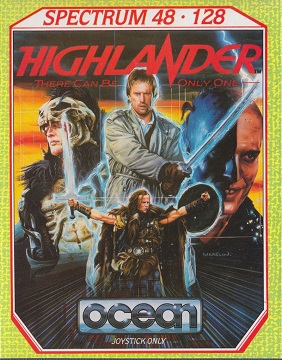
Highlander is a 1986 fighting game developed by Canvas and published by Ocean Software for the ZX Spectrum, Commodore 64, and Amstrad CPC home computers. It is based on the 1986 film of the same name. Highlander was panned by reviewers.

Tiger Road is a hack and slash platform game originally released in 1987 as a coin-operated arcade video game.

Captain America in: The Doom Tube of Dr. Megalomann, also known as Captain America Defies The Doom Tube, is a video game based on a comic book series of the same name. It was published in 1987 by U.S. Gold on their Go! label for computers including the Amstrad CPC and the Commodore 64 and was published a year later on the ZX Spectrum. Reviews were mixed, with the graphics and audio generally seen as poor. It is the first video game to feature Captain America.

Leader Board is a series of golf simulation video games that was developed by Bruce Carver and Roger Carver, and published by Access Software.
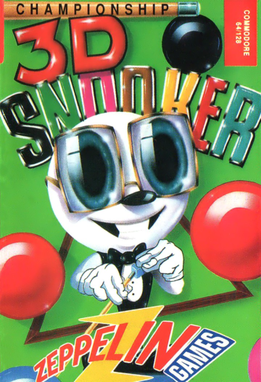
Championship 3D Snooker is a sports simulation video game developed and created by Steven Walters and published by Zeppelin Games Limited in 1992. Championship 3D Snooker simulates the cue sport snooker, and is an early pioneer of 3D computer graphics in snooker games, first used in Jimmy White's 'Whirlwind' Snooker, and would be adopted for most snooker games that followed, including the Virtual Pool series.
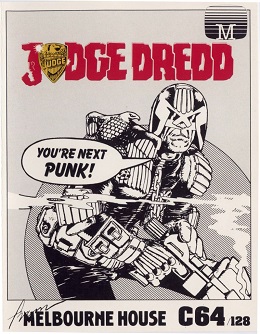
Judge Dredd is a platform shoot 'em up video game based on the character of the same name. It was developed by Beam Software and published by Melbourne House. It was released in Europe in 1986, for Commodore 64 and ZX Spectrum.

The Race Against Time is a 1988 adventure video game designed by the Oliver Twins, and developed and published by Codemasters. The player controls Sudanese runner Omar Khalifa, who has to venture to six continents to light torch bowls and raise flags to begin the 1988 Sport Aid, a sport-themed charity organization. A tie-in to the Sport Aid charity, all proceeds were donated to the campaign. The game was released for the Amstrad CPC, Commodore 64, and ZX Spectrum platforms.
